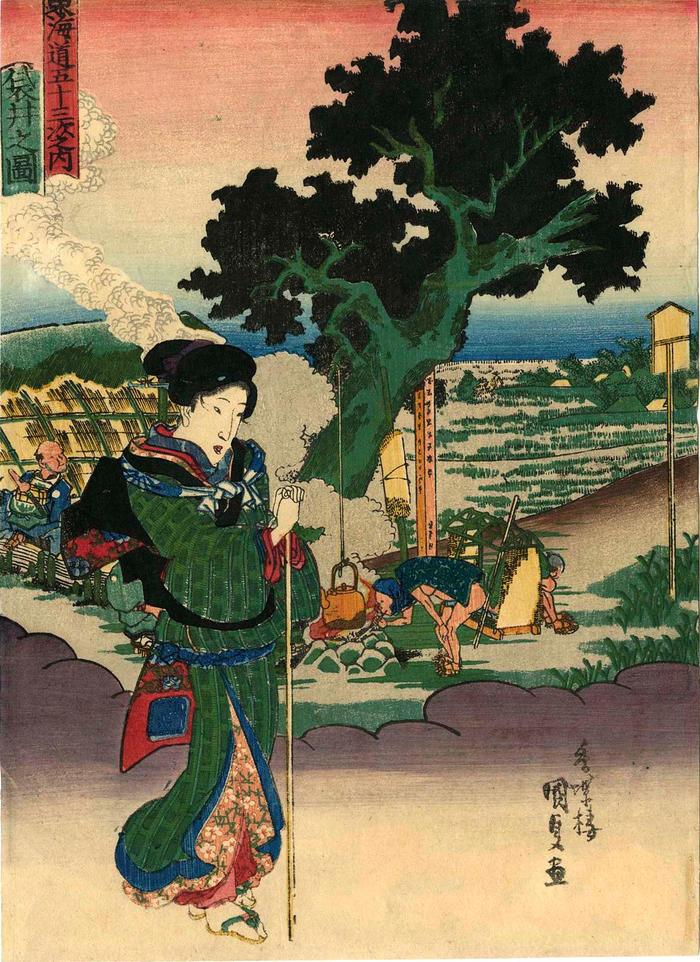Utagawa Kunisada (歌川国貞) / Toyokuni III (三代豊国) (artist 1786 – 01/12/1865)
View of Fukuroi (Fukuroi no zu: 袋井之図) from the series Fifty-three Stations of the Tōkaidō Road (Tōkaidō gojūsan tsugi no uchi: 東海道五十三次之内)
ca 1838
7 in x 9.75 in (Overall dimensions) Japanese woodblock print
Signed: Kōchōrō Kunisada ga (香蝶楼国貞画)
No publisher's seal
No censor's seal
Museum of Fine Arts, Boston - published by Moriya Jihei with kiwame seal
National Diet Library - published by Moriya Jihei and Sanoya Kihei
Spencer Museum of Art - published by Moriya Jihei
Museum für angewandte Kunst, Vienna
British Museum - Hiroshige's 'Fukuroi de-chaya no zu' version
Virginia Museum of Fine Art
Ishikawa Prefectural Museum of Art - they date their copy to 1836
Bryn Mawr
Honolulu Museum of Art - published by Moriya Jihei - ca. 1830-35
Google maps - Fukuroi, Shizuoka, Japan
Honolulu Museum of Art - published by Moriya Jihei - 1848
Fujisawa Ukiyo-e Museum
Victoria and Albert Museum
Nelson-Atkins Museum of Art This print is number 28 in the series, but is more often listed as the 27th station. The curatorial file at Museum für angewandte Kunst in Vienna note: "The scenery resembles the template by Hiroshige again. Kunisada pulls the representation of guests at the tea stand apart a little to place the woman in the foreground in between."
Kunisada's chūban Bijin Tokaido (東海道美人) series was first published around 1833, after Hiroshige's famous series was underway but not yet complete.
****
In Tokaido Landscapes: The Path from Hiroshige to Contemporary Artists, 2011, #28, p. 40, speaking of the original Hiroshige print it says in a text by Sasaki Moritoshi: "A signpost is visible, so we know it is either the eastern or western entrance to the station. The setting of the print is a tea hut, a makeshift stall by the roadside. A large kettle is hanging from the branch of a tree, and the activity centers on this kettle. The woman checking on the fire [blocked from our view by the bijin in the Kunisada print] is the shopkeeper. Taking a rest are two palanquin bearers on the right and a man who appears to be a courier on the left. Like the stone in Nissaka, the kettle draws people's attention and serves as the center of gravity for the print. The expanse of the post-harvest rice fields and the clear, autumnal sky are pleasant."
****
In Hiroshige: l'art du voyage, Paris, 2012, p. 70 it says that Fukuroi is the mid-point of the journey between Kyoto and Edo. It is about 146.6 miles in either direction.
****
Muneshige Narazaki in Masterworks of Ukiyo-e: Hiroshige, the 53 Stations of the Tōkaidō (p. 58) noted: "Details like the smoke rising from the fire under the kettle and the swallow perched on the signboard at the right [missing in the Kunisada version] give credence to the placid rusticity of the scene. Today the road is a highway full of speeding trucks."
****
Reiko Mochinaga Brandon, the curator of textiles at the Honolulu Academy of Arts, gives an interesting description of the elements, such as clothing, in the Hiroshige version of this scene. She notes that the palanquin carrier who is bent over the fire to light his pipe is wearing a sleeveless jacket and has a blue tenugui wrapped around his head. Leaning against the tree trunk, wrapped in part with straw, is the long pole the carriers use to support the palanquin. "Inside the tea stall a mail courier (hiyaku)), wearing a stomach protector (haragake) and a working man's tight pants (momohiki, sits back to enjoy a momentary break, leisurely smoking a pipe." The pipe doesn't appear in the Kunisada version, nor is it clearly made out what the lower part of him looks like.
In the Hiroshige a bird sits perched atop the tatefuda or notice board. As we noted elsewhere, the bird is absent in from this print in the Lyon Collection. Another difference is that in the Hiroshige a man in the distance is leading a horse, but neither the man nor the horse appear in the Kunisada.
Source and quotes from: Hokusai and Hiroshige: Great Japanese Prints from the James A. Michener Collection, Honolulu Academy of Arts, 2nd printing 1999, p. 20.
****
Illustrated in a small color reproduction in Kunisada's Tokaido: Riddles in Japanese Woodblock Prints by Andreas Marks, Hotei Publishing, 2013, page 69, T24-28.
landscape prints (fūkeiga 風景画) (genre)
beautiful woman picture (bijin-ga - 美人画) (genre)
